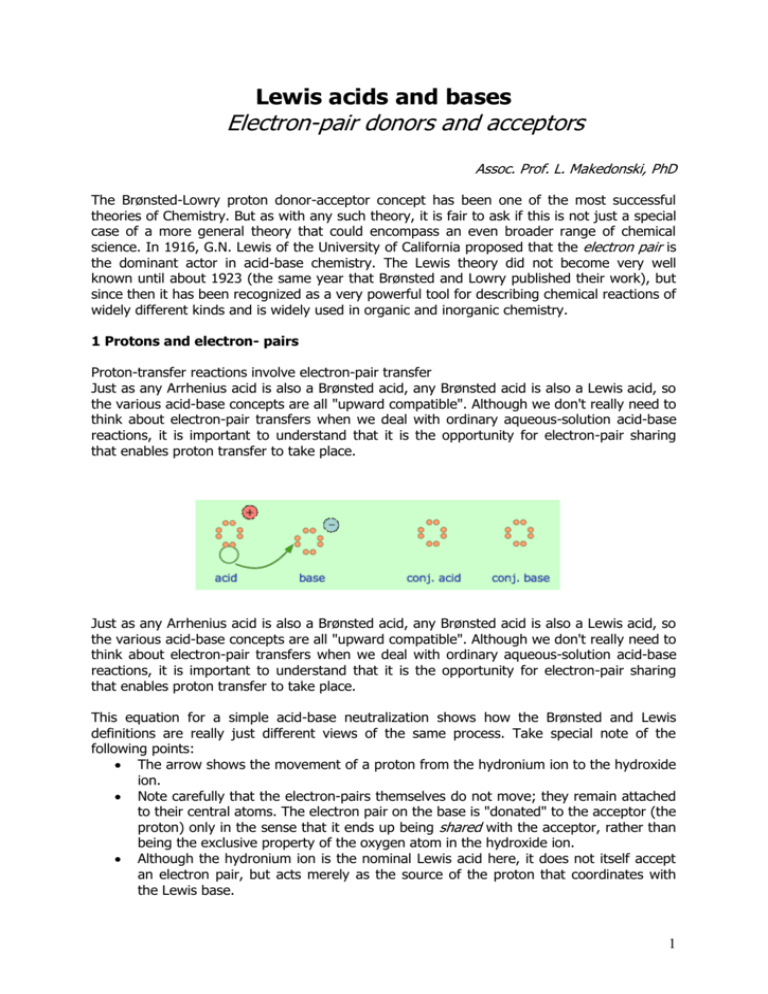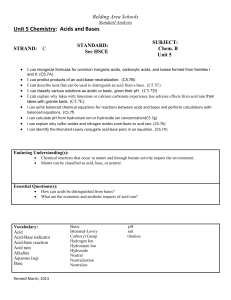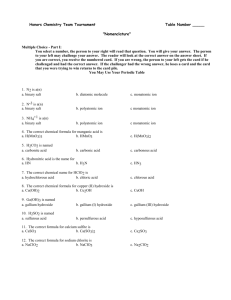Lewis acids and bases
advertisement

Lewis acids and bases Electron-pair donors and acceptors Assoc. Prof. L. Makedonski, PhD The Brønsted-Lowry proton donor-acceptor concept has been one of the most successful theories of Chemistry. But as with any such theory, it is fair to ask if this is not just a special case of a more general theory that could encompass an even broader range of chemical science. In 1916, G.N. Lewis of the University of California proposed that the electron pair is the dominant actor in acid-base chemistry. The Lewis theory did not become very well known until about 1923 (the same year that Brønsted and Lowry published their work), but since then it has been recognized as a very powerful tool for describing chemical reactions of widely different kinds and is widely used in organic and inorganic chemistry. 1 Protons and electron- pairs Proton-transfer reactions involve electron-pair transfer Just as any Arrhenius acid is also a Brønsted acid, any Brønsted acid is also a Lewis acid, so the various acid-base concepts are all "upward compatible". Although we don't really need to think about electron-pair transfers when we deal with ordinary aqueous-solution acid-base reactions, it is important to understand that it is the opportunity for electron-pair sharing that enables proton transfer to take place. Just as any Arrhenius acid is also a Brønsted acid, any Brønsted acid is also a Lewis acid, so the various acid-base concepts are all "upward compatible". Although we don't really need to think about electron-pair transfers when we deal with ordinary aqueous-solution acid-base reactions, it is important to understand that it is the opportunity for electron-pair sharing that enables proton transfer to take place. This equation for a simple acid-base neutralization shows how the Brønsted and Lewis definitions are really just different views of the same process. Take special note of the following points: The arrow shows the movement of a proton from the hydronium ion to the hydroxide ion. Note carefully that the electron-pairs themselves do not move; they remain attached to their central atoms. The electron pair on the base is "donated" to the acceptor (the proton) only in the sense that it ends up being shared with the acceptor, rather than being the exclusive property of the oxygen atom in the hydroxide ion. Although the hydronium ion is the nominal Lewis acid here, it does not itself accept an electron pair, but acts merely as the source of the proton that coordinates with the Lewis base. 1 The point about the electron-pair remaining on the donor species is especially important to bear in mind. For one thing, it distinguishes a Lewis acid-base reaction from an oxidation-reduction reaction, in which a physical transfer of one or more electrons from donor to acceptor does occur. The product of a Lewis acid-base reaction is known formally as an "adduct" or "complex", although we don't ordinarily use these terms for simple proton-transfer reactions such as the one in the above example. Here, the proton combines with the hydroxide ion to form the "adduct" H2O. The following examples illustrate these points for some other proton-transfer reactions that you should already be familiar with. Ammonia is both a Brønsted and a Lewis base, owing to the unshared electron pair on the nitrogen. The reverse of this reaction represents the hydrolysis of the ammonium ion. Because HF is a weak acid, fluoride salts behave as bases in aqueous solution. As a Lewis base, F– accepts a proton from water, which is transformed into a hydroxide ion. The bisulfite ion, being amphiprotic, can act as an electron donor or acceptor. 2 2 Acid-base reactions without protons The major utility of the Lewis definition is that it extends the concept of acids and bases beyond the realm of proton transfer reactions. The classic example, given in every textbook, is the reaction of boron trifluoride with ammonia to form an adduct: BF3 + NH3 → F3B-NH3 If you are already familiar with the concept of hybrid orbitals, this diagram might help you visualize this process. The lone pair electrons on the nitrogen atom can be accommodated in the empty 2pz orbital of BF3, creating a shared-electron B–N bond. One of the most commonly-encountered kinds of Lewis acid-base reactions occurs when electron-donating ligands form coordination complexes with transition-metal ions. In this example, the tin atom in SnCl4 can expand its valence shell by utilizing a pair of dorbitals, changing its hybridization from sp3 to sp3d2. Applications to organic reaction mechanisms Although organic chemistry is beyond the scope of these lessons, it is instructive to see how electron donors and acceptors play a role in chemical reactions. The following two diagrams show the mechanisms of two common types of reactions initiated by simple inorganic Lewis acids: 3 In each case, the species labeled "Complex" is an intermediate that decomposes into the products, which are conjugates of the original acid and base pairs. The electric charges indicated in the complexes are formal charges, but those in the products are "real". In (1), the incomplete octet of the aluminum atom in AlCl3 serves as a better electron acceptor to the chlorine atom than does the isobutyl part of the base. In (2), the pair of non-bonding electrons on the dimethyl ether coordinates with the electron-deficient boron atom, leading to a complex that breaks down by releasing a bromide ion. 3 Non-aqueous protonic acid-base systems We ordinarily think of Brønsted-Lowry acid-base reactions as taking place in aqueous solutions, but this need not always be the case. A more general view encompasses a variety of acid-base solvent systems, of which the water system is only one. Each of these has as its basis an amphiprotic solvent (one capable of undergoing autoprotolysis), in parallel with the familiar case of water. pH and titration Aqueous solutions of acids and bases 1 Dissociation of water The ability of acids to react with bases depends on the tendency of hydrogen ions to combine with hydroxide ions to form water: H+(aq) + OH–(aq) → H2O (1) This tendency happens to be very great, so the reaction is practically complete— but not "completely" complete; a few stray H+ and OH– ions will always be present. What's more, this is true even if you start with the purest water attainable. This means that in pure water, the reverse reaction, the "dissociation" of water H2O → H+(aq) + OH–(aq) (2) will proceed to a very slight extent. Both reactions take place simultaneously, but (1) is so much faster than (2) that only a minute fraction of H2O molecules are dissociated. Liquids that contain ions are able to conduct an electric current. Pure water is practically an insulator, but careful experiments show that even the most highly purified water exhibits a very slight conductivity that corresponds to a concentration of both the H+ ion and OH– ions of almost exactly 1.00 × 10–7mol L–1 at 25°C. Ion product of water The degree of dissociation of water is so small that you might wonder why it is even mentioned here. The reason stems from an important relationship that governs the concentrations of H+ and OH– ions in aqueous solutions: [H+][OH–] = 1.00 × 10–14 (3) The quantity 1.00 x 10–14 is commonly denoted by Kw. Its value varies slightly with temperature, pressure, and the presence of other ions in the solution. in which the square brackets [ ] refer to the concentrations (in moles per litre) of the substances they enclose. 4 This expression is known as the ion product of water, and it applies to all aqueous solutions, not just to pure water. The consequences of this are far-reaching, because it implies that if the concentration of H+ is large, that of OH– will be small, and vice versa. This means that H+ ions are present in all aqueous solutions, not just acidic ones. Take special note of the followng definition: A neutral solution is one in which the concentrations of H+ and OH– ions are identical. The values of these concentrations are constrained by Eq. 3. Thus, in a neutral solution, both the hydrogen- and hydroxide ion concentrations are 1.00 × 10–7 mol L–1: [H+][OH–] = [1.00 × 10–7][1.00 × 10–7] =1.00 × 10–14 Hydrochloric acid is a typical strong acid that is totally dissociated in solution: HCl → H+(aq) + Cl–(aq) A 1.0M solution of HCl in water therefore does not really contain any significant concentration of HCl molecules at all; it is a solution in of H+ and Cl– in which the concentrations of both ions are 1.0 mol L–1. The concentration of hydroxide ion in such a solution, according to Eq 2, is [OH–] = (Kw)/[H+] = (1.00 x 10–14) / (1 mol L–1) = 1.00 x 10–14 mol L–1. Similarly, the concentration of hydrogen ion in a solution made by dissolving 1.0 mol of sodium hydroxide in water will be 1.00 x 10–14 mol L–1. 2 pH When dealing with a range of values (such as the variety of hydrogen ion concentrations encountered in chemistry) that spans many powers of ten, it is convenient to represent them on a more compressed logarithmic scale. By convention, we use the pH scale to denote hydrogen ion concentrations: pH = – log10 [H+] (4) or conversely, [H+] = 10–pH . This notation was devised by the Danish chemist Søren Sørensen (1868-1939) in 1909. There are several accounts of why he chose "pH"; a likely one is that the letters stand for the French term pouvoir hydrogène, meaning "power of hydrogen"— "power" in the sense of an exponent. It has since become common to represent other small quantities in "pnotation". Two that you need to know in this course are the following: pOH = – log10 [OH–] pKw = – log Kw (= 14 when Kw = 1.00 × 10–14) Note that pH and pOH are expressed as numbers without any units, since logarithms must be dimensionless. Recall from Eq 3 that [H+][OH–] = 1.00 × 10–14; if we write this in "p-notation" it becomes pH + pOH = 14 (5) In a neutral solution at 25°C, pH = pOH = 7.0. As pH increases, pOH diminishes; a higher pH corresponds to an alkaline solution, a lower pH to an acidic solution. In a solution with 5 [H+] = 1 M , the pH would be 0; in a 0.00010 M solution of H+, it would be 4.0. Similarly, a 0.00010 M solution of NaOH would have a pOH of 4.0, and thus a pH of 10.0. It is very important that you thoroughly understand the pH scale, and be able to convert between [H+] or [OH–] and pH in both directions. The pH scale The range of possible pH values runs from about 0 to 14. The word "about" in the above statement reflects the fact that at very high concentrations (10 M hydrochloric acid or sodium hydroxide, for example,) a significant fraction of the ions will be associated into neutral pairs such as H+·Cl–, thus reducing the concentration of “available” ions to a smaller value which we will call the effective concentration. It is the effective concentration of H+ and OH– that determines the pH and pOH. For solutions in which ion concentrations don't exceed 0.1 M, the formulas pH = –log [H+] and pOH = – log[OH–] are generally reliable, but don't expect a 10.0 M solution of a strong acid to have a pH of exactly –1.00! The colors of many dye-like compounds depend on the pH, and can serve as useful indicators to determine whether the pH of a solution is above or below a certain value. Universal indicators Most indicator dyes show only one color change, and thus are only able to determine whether the pH of a solution is greater or less than the value that is characteristic of a particular indicator. By combining a variety of dyes whose color changes occur at different pHs, a "universal" indicator can be made. Commercially-prepared pH test papers of this kind are available for both wide and narrow pH ranges. 3 Titration Since acids and bases readily react with each other, it is experimentally quite easy to find the amount of acid in a solution by determining how many moles of base are required to neutralize it. This operation is called titration, and you should already be familiar with it from your work in the Laboratory. We can titrate an acid with a base, or a base with an acid. The substance whose concentration we are determining (the analyte) is the substance being titrated; the substance we are adding in measured amounts is the titrant. The idea is to add titrant until the titrant has reacted with all of the analyte; at this point, the number of moles of titrant added tells us the concentration of base (or acid) in the solution being titrated. Titration curves The course of a titration can be followed by plotting the pH of the solution as a function of the quantity of titrant added. The figure shows two such curves, one for a strong acid (HCl) and the other for a weak acid, acetic acid, denoted by HAc. Looking first at the HCl curve, notice how the pH changes very slightly until the acid is almost neutralized. At that point, which corresponds to the vertical part of the plot, just one additional drop of NaOH solution will cause the pH to jump to a very high value— almost as high as that of the pure NaOH solution. 6 Compare the curve for HCl with that of HAc. For a weak acid, the pH jump near the neutralization point is less steep. Notice also that the pH of the solution at the neutralization point is greater than 7. These two characteristics of the titration curve for a weak acid are very important for you to know. If the acid or base is polyprotic, there will be a jump in pH for each proton that is titrated. In the example shown here, a solution of carbonic acid H2CO3 is titrated with sodium hydroxide. The first equivalence point (at which the H2CO3 has been converted entirely into bicarbonate ion HCO3–) occurs at pH 8.3. The solution is now identical to one prepared by dissolving an identical amount of sodium bicarbonate in water. Addition of another mole equivalent of hydroxide ion converts the bicarbonate into carbonate ion and is complete at pH 10.3; an identical solution could be prepared by dissolving the appropriate amount of sodium carbonate in water. Finding the equivalence point: indicators When enough base has been added to react completely with the hydrogens of a monoprotic acid, the equivalence point has been reached. If a strong acid and strong base are titrated, the pH of the solution will be 7.0 at the equivalence point. However, if the acid is a weak one, the pH will be greater than 7; the “neutralized” solution will not be “neutral” in terms of pH. For a polyprotic acid, there will be an equivalence point for each titratable hydrogen in the acid. These typically occur at pH values that are 4-5 units apart, but they are occasionally closer, in which case they may not be readily apparent in the titration curve. The key to a successful titration is knowing when the equivalance point has been reached. The easiest way of finding the equivalence point is to use an indicator dye; this is a substance whose color is sensitive to the pH. One such indicator that is commonly encountered in the laboratory is phenolphthalein; it is colorless in acidic solution, but turns intensely red when the solution becomes alkaline. If an acid is to be titrated, you add a few drops of phenolphthalein to the solution before beginning the titration. As the titrant is added, a local red color appears, but quickly dissipates as the solution is shaken or stirred. Gradually, as the equivalence point is approached, the color dissipates more slowly; the trick is to stop the addition of base after a single drop results in a permanently pink solution. 7







